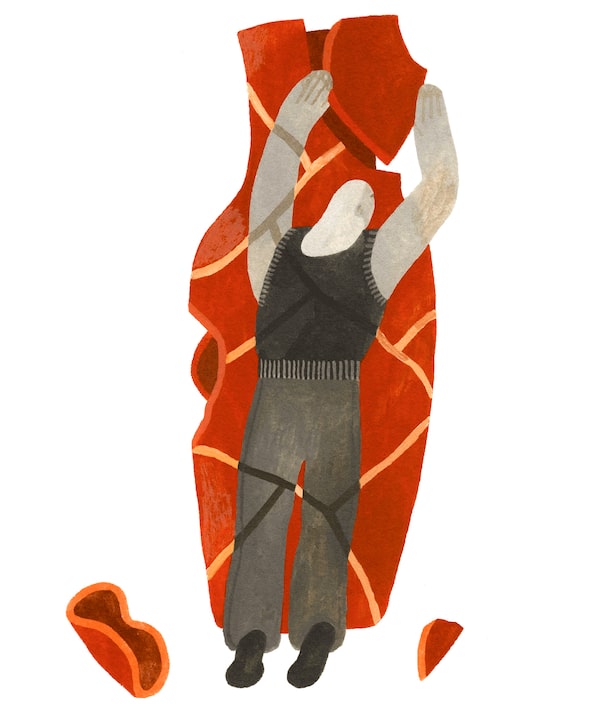First Person is a daily personal piece submitted by readers. Have a story to tell? See our guidelines at tgam.ca/essayguide.

Illustration by Mary Kirkpatrick
When I walked from our docked river cruise boat over to the central train station in Amsterdam, I was expecting to meet my smiling daughter. Years ago, she lived and worked in London and had flown in to Schiphol Airport to meet us as we finished up a river cruise. We would be able to spend a few days together before my husband and I had to fly back to Canada. Even better, this weekend was my birthday and I couldn’t think of a more perfect way to celebrate than a visit with our daughter, whom we hadn’t seen in almost six months.
But the girl who met us was tearful and distraught – obviously upset and unhappy.
Over coffee in a little café, she told us the story.
“I was in Paris for work a few weeks ago and a Parisienne colleague took me to this little shop in the Bastille District. They had the most beautiful things – and I found a brilliant red porcelain bottle that I thought would be a perfect birthday present for you, Mom.”
It was the venerable Porcelaine du Lot Virebent, a company with a long history and a lot of cachet whose creations have been exhibited at the Musée des Arts Décoratifs in Paris.
The saleslady had carefully packed the bottle in layers of tissue paper and double sealed it in a box for safe travel. Allie had brought it in her hand luggage when she flew to Amsterdam to meet us but the problems started at customs.
The customs official insisted that she open the box and show him the contents, even though it had just gone through the scanner.
I know my daughter – she doesn’t do well with bullies, especially men who are bullies (does anyone though?) – and this one was arrogant and rude. As passengers backed up waiting behind her, she had to cut the seals and open the box and take out the vase and unwrap it to show him. He barely looked at it, and then he just flicked his hand for her to move on. As she hurried to repack everything, the box fell to the floor and the bottle shattered.
“It was not a cheap thing, Mom! And now it is in pieces!”
A few warm stroopwafels, a cup of coffee and assurances that she was the only birthday present that mattered put her back in good spirits and we spent a happy weekend, visiting museums, dining well and enjoying being together for a while.
But I brought the box of ceramic fragments home with me, and they sat in their original box for years. Eight years, actually.
Enter the pandemic.
Scrolling through the internet, I came across an article about kintsugi – the Japanese art of repairing broken ceramics with gold. That, I thought, is the perfect solution to the red bottle and I read everything I could find on the art of kintsugi.
I discovered that it was more than an art – it was a philosophy, a belief that some things are worth saving, that broken things can be made more beautiful through a loving repair. It champions the idea of permanence as opposed to the more modern approach of discarding things that are no longer perfect. Kintsugi says that some things have a meaning and a history that transcend wear or damage. They have been loved and touched by many hands and retain some trace of all that use.
Legend says that kintsugi was born when an ancient Japanese emperor broke his favourite tea bowl and asked his craftsmen to repair it. The repair was ugly so the emperor ordered the bowl to be sent to gifted artisans who recognized that they could not remake the bowl exactly as it was. So they made it more beautiful, repairing the cracks with gold.
I needed to practise before attempting to repair the red bottle, so I found a small bowl that I had picked up at a sale at our local art school for $2. I put it in a paper bag and hit it with a hammer, breaking it into large pieces. It was painful to break something that was perfectly good and the bowl was actually quite lovely even though inexpensive, but I needed to practise. I had to find genuine urushi lacquer, read instruction articles and watch tutorials, but I learned the technique and finally repaired the bowl to a respectable state.
Then I tackled the bottle. It was slow work, requiring total concentration, the perfect task for pandemic times. Hours and days passed without me noticing.
I think it looks better now than before it was broken. The gold veins of repair stand out against the deep red, clearly showing where the breaks occurred. The bottle is, in my estimate, more beautiful because of its trauma. And it carries memories. I treasure it.
It strikes me that the kintsugi philosophy applies to people, too. We all suffer some damage as we age – from sadness, loss, even from use – how much wiser it is to celebrate the wear and tear of life, to turn the breakage and wear into ornament, to gild the scars. It is a sign that you have been useful and loved and that you have survived.
I find that very comforting.
Barbara Ramsay Orr lives in Burlington, Ont.
Sign up for the weekly Parenting & Relationships newsletter for news and advice to help you be a better parent, partner, friend, family member or colleague.